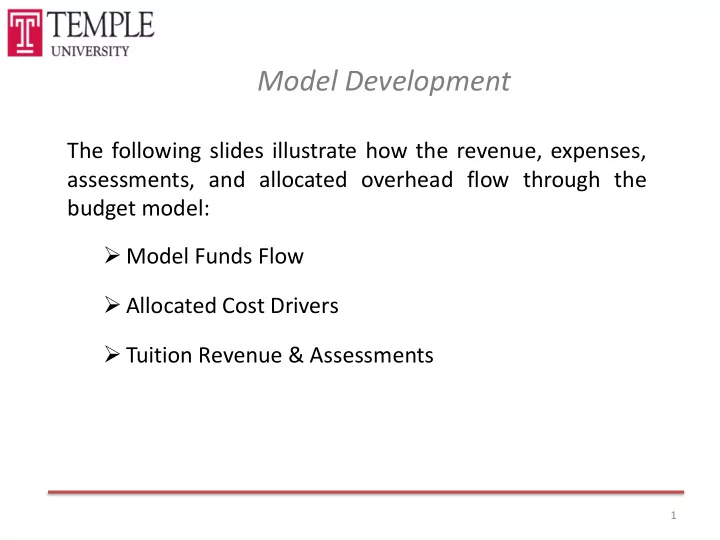

Model Development The following slides illustrate how the revenue, expenses, assessments, and allocated overhead flow through the budget model: Model Funds Flow Allocated Cost Drivers Tuition Revenue & Assessments 1
Model Development: Income Flow Student Tuition Income Other Revenue Generated Revenue TU Strategic Available Resources Fund Assessments Direct Expenses Allocated Costs (based upon Tuition Income Only) Student Tuition Income : This includes UG/Grad/Prof through both direct and transfer Other Income: This includes PA Public Welfare, Other Student Fees, ICR & Clinical Revenue TU Strategic Fund: To fund strategic initiatives within the Schools and Colleges Direct Expenses: Compensation, benefits, travel, faculty startup, tuition remission, etc. Allocated Costs: Support Unit funding Assessment Charge: Plant Fund, Financial Aid & Strategic Fund 2 2
Model Development Cost Drivers The amount of allocated costs is based on a formula that considers ‘cost drivers’ such as: • CHG Students (undergraduate, graduate & professional) • FTE Faculty (tenured/tenure track, non-tenure track) • FTE Staff • Total direct expenditures from all sources • Square footage • Solicitable alumni • Major donors ($5,000 and above) • Research expenditures 3
Model Development Support Centers with Allocated Cost Drivers Academic Auxiliary Computer Advancement Campus Safety Support Subsidy Services 80% 80% UG CHG Solicitable 80% UG CHG 40% UG CHG 40% UG CHG Living Alumni 10% Graduate 20% Major 10% Graduate 5% Graduate 5% Graduate CHG Donors CHG CHG CHG 10% Prof CHG 10% Prof CHG 5% Prof CHG 5% Prof CHG 25% Faculty 25% Faculty FTE FTE 25% Staff FTE 25% Staff FTE 4
Model Development Support Centers with Allocated Cost Drivers Facilities Financial Human General Faculty Affairs Administration Management Services Resources 100% Faculty 100% Direct 100% Direct 50% Faculty Space is first FTE Expenditures Expenditures FTE allocated to support units, then to 50% Staff FTE Revenue Centers at $24.52 per sq. ft. (FY2017 Rate) 5
Model Development Support Centers with Allocated Cost Drivers Student University Library Research Uncollectibles Services College 50% Faculty 60% UG CHG 80% UG CHG 80% UG CHG 85% UG CHG FTE 7.5% Graduate 50% Research 10% Graduate 10% Graduate 10% Graduate CHG Expenditures CHG CHG CHG 7.5% Prof CHG 10% Prof CHG 10% Prof CHG 5% Prof CHG 25% Faculty FTE 6
Allocation of Tuition Revenue Undergraduate Tuition Summer Revenue Fall and Spring Revenue 100% of +/ - Tuition 100% of School Specific 100% of Base Tuition into Gross Transfer Tuition Differential to Central UG Tuition Pool Revenue to (difference Home College Home College between what Allocated to Instructional is taken by College based upon prior your students fall and spring instructional across the credit hours University and what you teach) Total Tuition Revenue Less: Financial Aid Assessment (18.4% of UG Tuition*) Less: Plant Fund Assessment (5.0% of Total Tuition) = Net Tuition Revenue 7 *17.5% in FY2015
Allocation of Tuition Revenue Graduate Tuition 100% of Gross Revenue to Home College +/ - Tuition Transfer (difference between what is taken by your students across the University and what you teach) = Total Tuition Revenue Less: Financial Aid Assessment (1.9% of Graduate Tuition) * Less: Plant Fund Assessment (5.0% of Total Tuition) = Net Tuition Revenue * Assessed on Graduate Tuition generated by non-professional schools only (2.5% in FY2015). Medicine, Dentistry, Pharmacy, Podiatric Medicine and Law are excluded from this assessment. 8
Allocation of Tuition Revenue Professional Tuition 100% of Gross Revenue to Home College +/ - Tuition Transfer (difference between what is taken by your students across the University and what you teach) = Total Tuition Revenue Less: Plant Fund Assessment (5.0% of Total Tuition) = Net Tuition Revenue 9
Annual Budget Conferences & Funding Proposal Process Budget Conferences* Hold Prepare Dean/VP submits proposal Harmless Budget for strategic funds/annual reports electronically to CFO Request subvention Budget Office (Copy to Provost) Prepares Projections of Additions to December / Income, Costs & Hold Harmless January Expenditures Dean/VP presents strategic funds RC-level faculty proposal during budget conference advisory may be engaged in preparing RC request Budget Budget Budget conference participants *Budget Conference Participants evaluate funding proposal using Targets Preparation CFO faculty senate rubric or ‘scorecard’ • Provost Office Representative • • Faculty Representatives (2) Comprised April of Faculty Senate Steering Committee nominated faculty and RC-level Budget Review Committee delegates ) Participants provide rationale to • Deans (1) for SU & AUX Funding decisions CFO who assembles for final review • Budget Office Representative delivered to by Provost and President • Other: President will invite University Officers according to expertise needed Deans/VPs for review 10
Recommend
More recommend